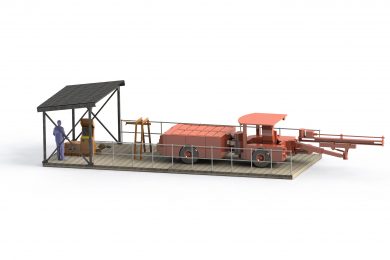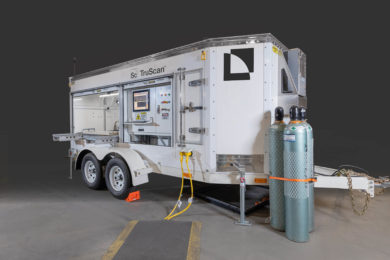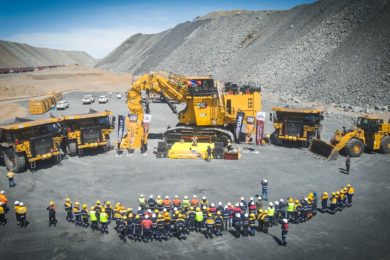South Africa’s CMTI Group says “cutting-edge locally-developed and patented technologies are providing underground and surface mines with a safer, as well as more reliable and efficient means of testing the braking systems of their mechanised production and transportation equipment.” The technologies are being manufactured at CMTI Group’s factory in Tshwane. This operation is being ramped-up to also meet the growing demand for the OEM’s other sophisticated technologies, including underground hybrid-diesel locomotives and ultra-low platforms.
These products are the outcome of years of research and development working in joint venture with some of the world’s largest gold and platinum-group metal (PGM) mining houses, and CMTI Group’s Managing Director, Dr Danie Burger, says that the company pursued a similar approach in the design of its integrated brake-testing technologies.
“They are based on the suggestions of a workgroup, comprising all mining houses and OEMs in the South African mining industry. Steered by Anglo Platinum’s De Wet Strydom, the workgroup was tasked with assisting in the design of a solution that would address the many challenges facing both underground and surface-mining operations,” Burger says.
For example, dynamic testing, used in underground mining environments, can cause unnecessary damage to trackless mobile mining (TMM) machines and only inspects the efficacy of the service-brake, as opposed to the entire system, including the park and emergency brakes, as well as accumulators. The technology is also not suited to testing tractor-trailer combinations due to the risk of “jack-knifing” the vehicles.
He also notes the important findings of extensive studies undertaken by the Mine Health and Safety Council that have shown that the technology can be up to 200% inaccurate when vehicles are tested at speeds of less than 12 km an hour as is also mentioned in SANS 1589.
Burger adds, “Mine personnel also do not realise that a 35% measurement reading on the service brakes of a vehicle on a decline with a gradient of 20% means that the vehicle has failed the test and is, therefore, non-compliant. It remains a serious concern that machines with brake efficiency levels of only 15% are being returned to service, despite the severe risk that they pose in already complex working environments.”
While causes of accidents, injuries and fatalities may vary, transport-related incidences remain one of the three main reasons for mine injuries in underground mining environments, according to the South African Chamber of Mines.
This includes the use of TMM machines, which are a critical component of the mechanisation of South Africa’s underground operations to ensure a safer working environment, in addition to their long-term sustainability by replacing out-dated mining methods.
CMTI Group has its roots in the industry’s drive to accelerate mechanisation, especially in the South African gold and PGM mining sectors, and the company’s innovations are already assisting these operations bolster both safety and productivity levels underground. “The transition to mechanisation is very important; however, it introduces new complexities that need to be carefully managed, not least of which is ensuring the sound performance of their braking systems. Our technology complements this strategy and is available at a time when there has been heightened call to accelerate the rate of modern mining technologies,” Burger says.
CMTI Group’s pull-brake tester for underground vehicles is semi-static to avoid damaging the brake system and is a safe means of testing the service, neutral and park/emergency brakes. In addition, all tests are undertaken with a 10% overload to facilitate the trending of brake degradation, while wear data is recorded and measured against the OEM’s standards.
All tests are photographed and a comprehensive report, including a time and date stamp, is generated for every test and can be used for legal purposes.
All trackless mining machines are pre-loaded into the system, streamlining the testing process by allowing the operator to merely select the relevant model and enter the plant number, while an e-mail notification is automatically sent directly to the relevant mine representatives in the event of a failure.
CMTI Group’s technology meets the stringent requirements of the Mine Health & Safety Act. The new regulations for the static testing of TMMs were implemented in February 2015 and are undertaken according to the SANS/ISO1589 standard.
They stipulate that the employer must take reasonable practical measures to ensure that people are not injured as a result of brake failure. These include ensuring that TMMs are operated with adequate and effective braking systems; and that all braking systems are adequately and routinely tested for intended functionality and are regularly maintained. Where a combined braking system is used, it needs to comply with the requirements for the separate systems and be fail-safe.
Meanwhile, the mandatory code of practice stipulates that conformity of production (COP) must describe the procedures for testing of braking systems to ensure functionality, in terms of brake-design specifications. This is relevant for static testing, dynamic-type or other testing methods for the recording and safe keeping of test results for a period specified by the COP.
The code also mandates the provision of brake descriptions, as well as the test procedures. These need to be supplied in table format, while some of them can be found in the American Federal Regulations, as well as EN, SABS, ISO and SAE standards. In addition, accumulator systems need to be tested for a number of applications and hold time.
SANS/ISO3450 is the standard by which testing of surface operated equipment is undertaken. However, Burger highlights that there are also glaring pitfalls in the standard ramp-testing system used to test the braking systems of large-surface mining machines. For instance, many of the ramps for testing purposes have been built at incorrect angles, despite the SANS 1589 also specifying that they must be at least four degrees steeper than the steepest gradient at a mine. The correct ramp procedures are also seldom followed in the testing of the service and neutral brake.
“Standards are also not adhered to in the testing of the park/emergency brake. Here, the test needs to be undertaken while the engine is off and the vehicle without an operator to ensure that the inspection is not being aided by the service brake. Meanwhile, the very accurate values in the gradient hold test stipulated by ISO3450 are seldom in line with the OEM’s specifications. For example, the service and park/emergency brake-testing specifications for a 100 t rigid-dump truck are to be undertaken at 20% and 15% slope gradients, respectively. However, some OEMs specify that testing of park brakes need to be undertaken on gradients of up to 15%. This means that the vehicle cannot be tested according to the standard as it will fail and even result in costly warranty-related issues with the manufacturer.”
CMTI Group has, therefore developed the SBT500 slab-brake tester for vehicles exceeding 50 t. This allows the vehicle to be tested on a moving platform that is hydraulically actuated and equipped with the necessary load cells to record the testing data. Burger concludes that CMTI Group is looking forward to working closely with mining houses to facilitate the wide-scale rollout of technologies that will complement their mechanisation and safety programmes.










